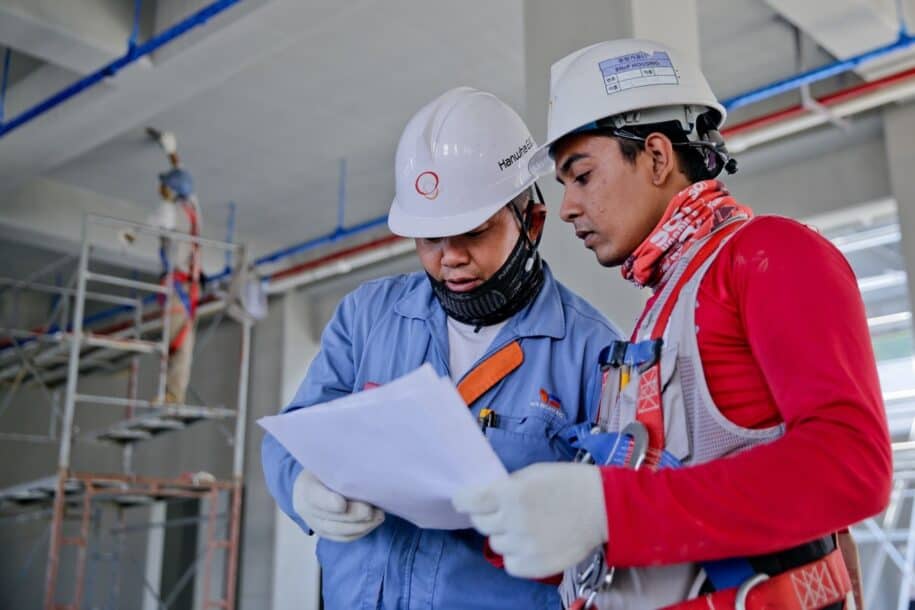Rapidly changing work conditions challenge businesses’ ability to keep the workplace as safe as possible. Prominent among these changes are the surging numbers of new technologies and processes, external stresses from the pandemic, and the heightened focus on holistic worker well-being, all of which highlight the importance of communication in establishing a safety culture focused on sustained improvement. This article presents 3 specific ways that communication enhances workplace safety.
1. Communication improves the hazard identification process.
Preventing workplace illnesses, injuries, and fatalities starts with identifying hazards. While safety inspectors can identify the typical dangers in a particular job, it is only by engaging the employees that daily perform these operations that the former can paint a complete picture of the hazard scenarios of that job. Solid communication is critical in the process of eliciting employee feedback regarding the hazards they encounter. If psychological safety is not present in an organization, or other means of promoting open feedback are lacking, hazards may go unnoticed or overlooked. The Occupational Health and Safety Administration cites employee involvement as one of the cornerstones of an effective job hazard analysis, mainly because of their unique experiences conducting a particular job. For instance, introducing new procedures and processes to your workforce not only necessitates communication of the hazards that may be encountered and the safety protocols to avoid them but also feedback from workers regarding their personal experiences performing a similar job. By combining inspectors’ expertise with effective employee communication, oversights in hazard identification can be substantially minimized, which leads to a more grounded health and safety program.
2. Communication helps employees adhere to safety protocols.
There is a direct correlation between an employee’s understanding of a safety protocol and their adherence to them. Without effective communication, this understanding will be lacking. Complying with regulatory safety standards, making personal protective equipment (PPE) widely available, and having suitable safety protocols can only contribute so much in the battle to ensure a safe working environment if employees have no willingness or ability to participate.
Communicating safety protocols can be accomplished by conducting regular training. This form of communication is the starting point for making sure employees have critical information regarding when and how to implement specific safety practices properly and why it is crucial. In the scenario that management must enforce the wearing of face masks in the workplace to avoid spreading respiratory diseases, an effective way of conducting the training (in which understanding is the ultimate goal) would be to first take into consideration that there are varying opinions regarding the recent pandemic. Then, management should explain the clear rationale for the new rule, making sure that policies are backed up with evidence. Finally, management should elicit feedback to follow up and check for understanding of the new practices. This assessment is necessary to ascertain if the rule will be adopted, if it can be adjusted, or if additional training is required.
3. Open communication channels encourage incident reporting.
The timely and accurate reporting of injuries, accidents, and near-misses is only possible with open communication between the management and employees. Incident reporting is vital for organizations to investigate accidents, put in place risk management strategies, and continuously improve safety protocols to prevent repeat incidents in the future. To encourage participation, mechanisms that enable employees to report safety incidents in real-time should be put in place. The process for reporting should also be straightforward enough that it will not be burdensome to complete and comprehensive enough to capture all the critical, contextual details.
In addition to making use of advanced reporting tools, management must maintain open lines of communication with employees with a focus on improving safety protocols. For example, to investigate an incident more productively, managers could ask why a specific protocol was not followed with a desire to adjust the protocol so that it could be more adequately applied, rather than using that line of communication to blame the incidents on employee action or inaction. In this way, management can implement more grounded interventions by addressing employee concerns and revealing the ownership of safety at the individual level, leading to a more robust safety program.
Communication plays a critical role in keeping today’s variable work environments safe. Efforts to comply with shifting regulations and maintain competitiveness by introducing new technologies into operations must be accompanied by effective communication. Creating open lines of communication with the workforce will help in identifying and dealing with hazards and applying safety protocols that were built with employee input. Furthermore, by harnessing the power of constructive input, management and workers can cooperatively work towards improving incident reporting and the overall safety program.
Author Bio
The SafetyStratus Research Advisory Group (RAG) brings together thought leaders from the global environmental, health, and safety community to promote best practices and provide key insights in the profession and the industries they serve. The Research Advisory Group also advocates, where practical, the intersection of and advances with the use of technology, such as the SafetyStratus enterprise EHS software platform. Group membership consists of representatives from across varied disciplines and market sectors as well as select members of the SafetyStratus team.
The primary objectives of the SafetyStratus RAG partnership are to:
- Build a strategic partnership between EHS practitioners and the SafetyStratus team.
- Provide engaging and practical content to the global EHS community.
- Provide discipline and market feedback specific to SafetyStratus products and services.
While the objectives of the RAG are varied, the primary public-facing outcome will be available through engaging and practical content found on the SafetyStratus resource pages. Various articles, papers, and other valuable resources will be produced and shared as part of an ongoing effort to cultivate a robust community. Ultimately, the SafetyStratus RAG will expand to have a broader reach and provide opportunities for more inclusion by all interested EHS professionals a collaborative community environment.
Sources
Occupational Health & Safety. (2018, November 6). Safety compliance: 4 strategies to get your employees on board. https://ohsonline.com/Articles/2018/11/06/Safety-Compliance-4-Strategies-to-Get-Your-Employees-on-Board.aspx?Page=1
Occupational Safety and Health Administration. (n.d.). Incident investigation. United States Department of Labor. https://www.osha.gov/incident-investigation#:~:text=Most%20importantly%2C%20it%20enables%20employers,necessary%20to%20prevent%20future%20incidents
Occupational Safety and Health Administration. (2002). Job Hazard Analysis (OSHA 3071). US Department of Labor. https://www.osha.gov/sites/default/files/publications/osha3071.pdf
Occupational Safety and Health Administration. (2021, June 10). Protecting workers: Guidance on mitigating and preventing the spread of COVID-19 in the workplace. United States Department of Labor. https://www.osha.gov/coronavirus/safework
Rigoni, B., & Nelson, B. (2016, May 24). Engaged workplaces are safer for employees. Gallup. https://news.gallup.com/businessjournal/191831/engaged-workplaces-safer-employees.aspx
Safety Talk Ideas. (2023). Communication and safety. https://www.safetytalkideas.com/safetytalks/communication-and-safety/



